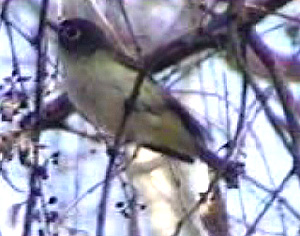A smallish looking vireo, about the size  and
overall appearance of Cassin's Vireo (not available for comparison), but with a much darker slate-blue face and
head. The white spectacles were very large, bold, and seemed unusually thick, recalling the appearance of Black-capped
Vireo.
and
overall appearance of Cassin's Vireo (not available for comparison), but with a much darker slate-blue face and
head. The white spectacles were very large, bold, and seemed unusually thick, recalling the appearance of Black-capped
Vireo.
The throat and chin were immaculate white, contrasting strongly with the dark cheeks and forming a crisp border with the dark area. There was no blending along the border as usually see on Cassin's Vireo. The white throat blended with the slightly dull breast and belly which showed a few smudged, dingy markings. The sides, flanks and undertail coverts were a fairly bright greenish-yellow, faintest on the sides.
The back was olive-green contrasting well with the slate-blue head. The wing coverts were heavily worn, revealing very narrow whitish wing-bars. The tertials were black and showed crisp clean whitish fringes on the outer webs.
The tail was relatively short, without tail spots, dark above and gray below with narrow white fringing on the outer web of outer rectrices extending all the way to the tip of each feather.
The eye was black, contrasting well with the white spectacles. The bill was fairly short, thick and slightly hooked at the tip, dark gray or blackish in color. The legs and feet were fairly thick and sturdy, and in good light appeared gray-blue. In shade they appeared dark. At one point the rear toenail was visible in silhouette. It was very short and strongly curved.
The most distinctive feature of the bird was its vocalizations. The song consisted of slow, measured, slurred phrases, somewhat like that of Cassin's Vireo, but the pitch was much higher, thinner and clearer. It totally lacked the burry quality of Cassin's or Plumbeous vireo. Other vocalizations included a rapid, descending, rippling chatter, somewhat goldfinch like, and a nasal scold note.

 Today, Robbie Fischer and I decided
to check Huntington Central for migrants. First we birded the area around Shipley Nature Center. As we were leaving
we met Jerry Tolman, Curtis Johnson and Loren Hays, who alerted us that Paul Klar had found a singing male Blue-headed
Vireo near the Gothard Street parking lot at the northeast section of the park. We immediately left to look for
it, but were unsuccessful in about 45 minutes of searching the area. Then Doug Willick, Brian Daniels and Jeff
Boyd arrived. Soon Brian heard the distinctive high slurred whistles of the Blue-headed Vireo high in a eucalyptus
near the picnic tables. We then studied the bird at close range for another 45 minutes or so as it fed fairly deliberately
in the eucalyptus. If fed mostly on Craneflies, but also caterpillars, etc. It was not observed to feed on the
lerps that infested the trees.
Today, Robbie Fischer and I decided
to check Huntington Central for migrants. First we birded the area around Shipley Nature Center. As we were leaving
we met Jerry Tolman, Curtis Johnson and Loren Hays, who alerted us that Paul Klar had found a singing male Blue-headed
Vireo near the Gothard Street parking lot at the northeast section of the park. We immediately left to look for
it, but were unsuccessful in about 45 minutes of searching the area. Then Doug Willick, Brian Daniels and Jeff
Boyd arrived. Soon Brian heard the distinctive high slurred whistles of the Blue-headed Vireo high in a eucalyptus
near the picnic tables. We then studied the bird at close range for another 45 minutes or so as it fed fairly deliberately
in the eucalyptus. If fed mostly on Craneflies, but also caterpillars, etc. It was not observed to feed on the
lerps that infested the trees.